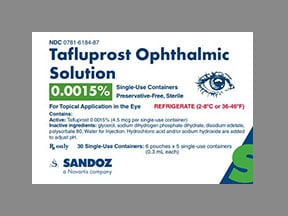
Tafluprost (pf) Coupons & Savings Card – Discount Prices from $50.93
Generic for: Zioptan
My prescription
Edit
0.0015%, Tafluprost (pf) (30 Solutions)
Select pharmacy

CVS
$50.93
COUPON PRICE
Walgreens
$74.99
COUPON PRICE
Albertsons
$121.59
COUPON PRICE
Walmart
$146.74
COUPON PRICETafluprost (pf) savings card
Show this card to your pharmacist
CVS
$50.93
BIN
ID
PCN
GRP
019876
LHA100868A
CHIPPO
LHX
Powered by
More prescriptions for glaucoma
More prescriptions for glaucoma
Tafluprost (pf) dosage forms
Dosage Quantity Price from Per unit 0.0015% 30 Solutions $50.93 $1.70 0.0015% 5 Solutions $23.74 $4.75 0.0015% 10 Solutions $29.18 $2.92
| Dosage | Quantity | Price from | Per unit |
|---|---|---|---|
| 0.0015% | 30 Solutions | $50.93 | $1.70 |
| 0.0015% | 5 Solutions | $23.74 | $4.75 |
| 0.0015% | 10 Solutions | $29.18 | $2.92 |
Tafluprost (pf) Warnings
Tafluprost, a medication used to lower elevated eye pressure in conditions like open-angle glaucoma and ocular hypertension, carries several important safety considerations:
Changes in Eye and Eyelid Pigmentation: Use of tafluprost may lead to increased pigmentation of the iris (the colored part of the eye), eyelid skin, and eyelashes. While eyelid and eyelash pigmentation changes may be reversible upon discontinuation, iris color changes are likely permanent.
Eyelash Alterations: Patients might experience gradual changes in their eyelashes, including increased length, thickness, color, and number. These changes are typically reversible after stopping the medication.
Intraocular Inflammation: Tafluprost should be used cautiously in individuals with active intraocular inflammation, such as iritis or uveitis, as it may exacerbate these conditions.
Macular Edema Risk: There have been reports of macular edema, including cystoid macular edema, in patients using prostaglandin analogs like tafluprost. Those who are aphakic (without a lens), pseudophakic with a torn posterior lens capsule, or have known risk factors for macular edema should use tafluprost with caution.
Use During Pregnancy and Breastfeeding: Tafluprost is not recommended during pregnancy unless the potential benefit justifies the potential risk to the fetus. It is also unknown whether tafluprost or its metabolites are excreted in human milk; therefore, caution is advised when administering tafluprost to nursing women.
Pediatric Use: The safety and efficacy of tafluprost in pediatric patients have not been established, and its use in this population is not recommended.
Patients should discuss these risks with their healthcare provider to determine if tafluprost is appropriate for their condition.
Tafluprost (pf) Side Effects
Tafluprost is a medication used to lower elevated intraocular pressure in individuals with open-angle glaucoma or ocular hypertension. While effective, it may cause certain side effects, primarily affecting the eyes. The most frequently reported side effect is conjunctival hyperemia, characterized by redness of the eye, occurring in approximately 4% to 20% of patients. Other common ocular side effects include stinging or irritation upon application, itching, dry eyes, eye pain, blurred vision, and increased sensitivity to light. These effects are typically mild and transient. Tafluprost may also lead to gradual changes in the appearance of the eyes and surrounding areas. Patients might notice a darkening of the iris (the colored part of the eye), which can be permanent. Additionally, there may be darkening of the eyelid skin and changes in eyelashes, such as increased length, thickness, and number. These eyelid and eyelash changes are usually reversible upon discontinuation of the medication. Less common side effects include headaches, cough, and symptoms resembling the common cold. Rarely, tafluprost has been associated with more serious conditions like macular edema (swelling in the central part of the retina) and exacerbation of asthma. It's important to inform your healthcare provider if you experience any new eye problems, such as vision changes, eye pain, or signs of infection. Regular eye examinations are recommended to monitor for potential side effects during treatment with tafluprost.
Tafluprost (pf) Interactions
When using tafluprost eye drops, it's important to be aware of potential interactions with other medications:
Nonsteroidal Anti-Inflammatory Drugs (NSAIDs): These medications, commonly used to reduce pain and inflammation, may affect the effectiveness of tafluprost. NSAIDs can either diminish or enhance tafluprost's ability to lower eye pressure.
Other Prostaglandin Analog Eye Drops: Using tafluprost alongside other prostaglandin analogs, such as Latanoprost, is generally not recommended. Combining these medications may lead to increased eye pressure.
Timolol Eye Drops: This beta-blocker, often prescribed for glaucoma, does not negatively interact with tafluprost.
Since tafluprost is applied directly to the eye and has minimal absorption into the bloodstream, it is unlikely to interact with oral medications. However, always inform your healthcare provider about all the medications you are taking, including over-the-counter drugs and supplements, to ensure safe and effective treatment.
